Hallo Friends Of Photography
You guys hear the term "interchangeable lens camera" (ILC) aka camera with a lens that could fit snugly, usually imprinted is following the ranks of DSLR camera lenses are large and heavy.
But not all of the ILC may be classed as Digital Single-Lens Reflex (DSLR).
In recent years, has been circulating a new kind of ILC in size much more concise.
This camera categories customarily known by the term ILC Mirrorless (MILC) or for brevity just mirrorless.
What is a mirrorless camera?
According to his epithet meaning "without mirror", is in fact a mirrorless DSLR omitted parts light reflectors (mirrorbox).
Without a functioning mirrorbox deflect the light from the lens into the optical viewfinder, the camera size mirrorless could be made far shrunk compared to a DSLR, while still maintaining the quality of the lens and image capture can be fit snugly.
Between the mirrorless and DSLR
Because does not have a mirrorless camera, mirrorbox has a number of fundamental differences with a DSLR in addition to its relatively smaller and simpler construction (without mechanical components for mirrorbox).
First, the mirrorless has no optical viewfinder (OVF, optical viewfinder).
The process of framing pictures or targeting is done via the LCD screen or electronic viewfinder (EVF, electronic viewfinder).
The workings of the EVF is actually the same as the LCD screen, namely transmit images via sensors that continuously active.
It's just a different size and placement, i.e. made similar optical viewfinder to "dikeker" with one eye.
OVF EVF has advantages compared to, for example, the user can instantly see the changes the results of the exposure when adjusting the aperture like paramenter, ISO, or white balance.
Can also be added to overlay a variety of useful information, such as a level indicator or histogram for exposure Guide.
The drawback, the EVF is more wasteful power because the camera must always turn on the sensor and the viewfinder display so that users can see the images.
DSLR users can see an object that is in front of the lens (Through The Lens, TTL) through the OVF when the camera is not turned on.
This is because the mechanism of the mirrorbox continued light from the lens toward pentaprisma, and viewfinder, without regarding the sensor.
Instead, the EVF on a mirrorless would appear to be pitch black when the camera is not turned on. If the camera is turned on and the sensor is active, then the images are "seen" by the lens can be shown on the EVF mirrorless.
When worn aiming through the LCD, good mirrorless DSLR or (through Live View) using the same basic principles, namely the forward image that captured the sensor onto the screen.
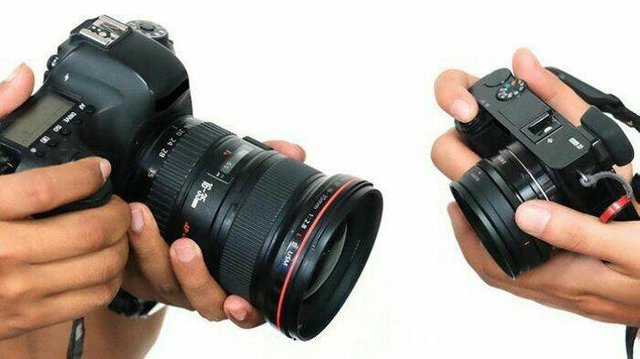
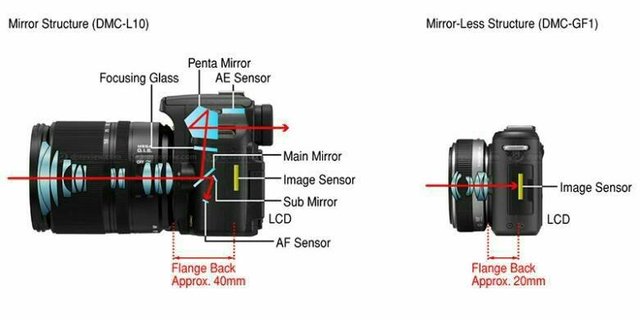
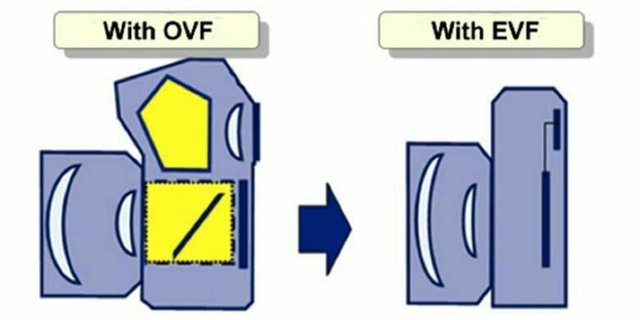
Different sensors
The second difference, mirrorless do metering (metering) and locking the focus directly from the image sensor.
As for DSLR sensor-sensor is different for those purposes which is separate from the main image sensor.
Metering and autofocus sensor DSLR respectively located above and under the mechanism of the mirrorbox.
The incoming light from the lens is deflected by a mirror mirrorbox in order to participate on the two sensors (in addition to being forwarded to OVF), to perform measurements of light and focus.
When the user presses the shutter button, that mirror the mirrorbox uplifted so that light could be forwarded to the main image sensor to take photos.
Impressed complicated? Rightly so.
This is why the process of making a DSLR should be done on precision mechanical components since the number involved.
The thinner, more flexible
Then the third difference lies on lens.
Mirrorbox disappearance led to the flange focal distance of the lens holder aka the distance from the image sensor to join trousers trimmed.
The result, though most of the mirrorless camera manufacturers also produce (or at least never produced) DSLR, they cannot necessarily be pair lens mirrorless camera with DSLR.
Need to be made a new line of lenses specifically designed for mirrorless, in order to adjust to the flange focal distance is shorter of yesteryear and also with the focus mechanism is directly from the sensor.
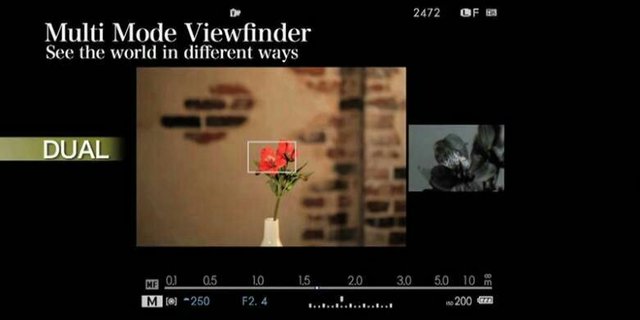
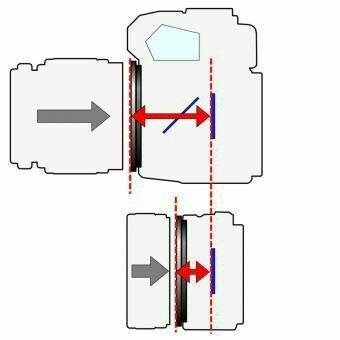
The reduction flange focal distance results in two advantages, namely the mirrorless camera body could be made thinner, not "fat" like a DSLR should provide a place for the mirrorbox.
Lens mirrorless usually designed to be smaller than a DLSR lenses classmates.
Remember the pancake lens? This type of thin lens was developed so that suitable mirrorless cameras are used to.
Another advantage of mirrorless cameras, more flexible lens problem lens fitted can alias-lenses for different camera systems with the help of adapters, including the lens belongs to a DSLR.
This adapter to function adds to the "distance" between the lens holder with the image sensor to compensate for flange focal distance the trousers trimmed.
In most cases, the use of adapters eliminate the special functions of the lens, such as autofocus and image stabilizer.
But there is also a special adapter that is capable of powering the functions via the mirrorless cameras, such as the EOS series of mirrorless-owned M-made Canon.
Sure, sometimes a great DSLR lens and less severe suited the mirrorless camera paired with a petite.
Because of that line of lenses that are specially designed for native mirrorless remained more practical.
More options
The first mirrorless camera is the Panasonic Lumix DMC-G1 was released to the market in 2008. When that shape is still resembles a DSLR with the "hump" that contains the viewfinder.
Some time after the Lumix G1, mirrorless cameras began to appear with more concise form, similar to pocket camera with a removable lens, such as the Pen E-P1 from Olympus and Lumix GF1, Panasonic-made too.
Mirrorless camera with a more concise form and without a hump is known as "rangefinder style", referring to the traditional rangefinder camera in the shape of a rectangle.
Mirrorless camera rangefinder style part that is intended for a lay consumer rely solely on LCD screen (usually touch screen) for the purposes of snapping, but there are others that come on the top left corner of the EVF camera.
Currently the majority of mirrorless cameras that circulated practically embraced the second form factor, similar to the traditional DSLR with EVF hump, contains or similar rangefinder.
Which one is more suitable depending on the taste of the user.
There is nothing like the compact mirrorless camera form ala rangefinder, there are also more comfortable with mirrorless DSLR-style shape with a handgrip and lots of buttons for manual settings.
Of the two form factors, mirrorless already more diverse than the average DSLR carrying similar forms, always with a hump, handgrip, and curvaceous body.
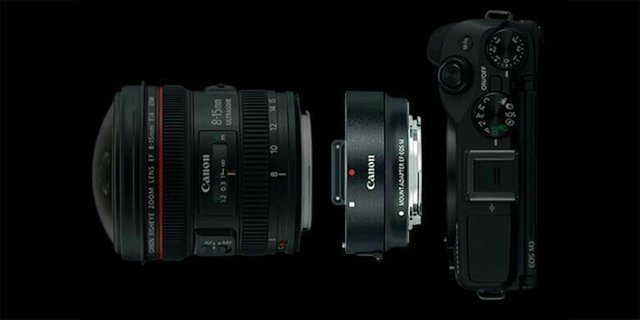
Not to mention calculating diversity system type (brand) are available.
Different from the practical DSLR market is dominated by Canon and Nikon, the number of manufacturers who are trying their luck in the mirrorless realm more.
There are Panasonic and Olympus which can mutually exchanged lensanya, and Sony and Fujifilm, Leica, even next to the two players of the old Canon and Nikon.
Range of accessories such as a flashgun to the microphone that can be paired with mirrorless camera had many outstanding.
Sensor size that can be selected is also more varied kind. Want a lens-lens Petite?
There are manufacturers who make mirrorless with a 1 inch sensor or micro four-thirds.
Want maximum image quality?
There is also the manufacturer of the measuring sensor with a mirrorless APS-C and full frame.
One thing that may still be a stumbling block was the availability of types of lenses that have not been as much of a DSLR, especially for a series of professional lenses, super telephoto or specialized lens like a tilt-shift, even though this constraint can be overcome by more or less wear lens adapter.
However, slowly but surely, mirrorless pursuit failed.
Like the focus speed issues that now no longer a scourge, not do not may someday mirrorless could emulate or even DSLR passes in all things.
Thankyou for information
Downvoting a post can decrease pending rewards and make it less visible. Common reasons:
Submit
Good blog post - please cite your sources (esp for photos). Unless of course they're yours.
Downvoting a post can decrease pending rewards and make it less visible. Common reasons:
Submit
Thank you so much @deveerei
Downvoting a post can decrease pending rewards and make it less visible. Common reasons:
Submit